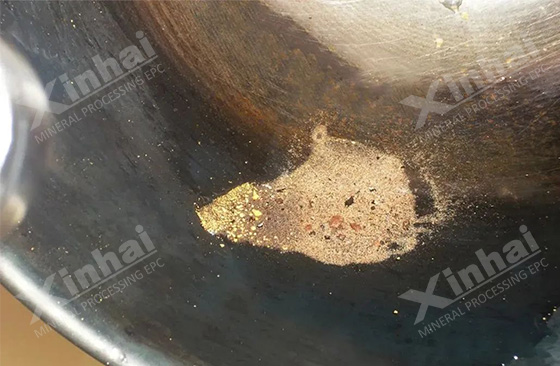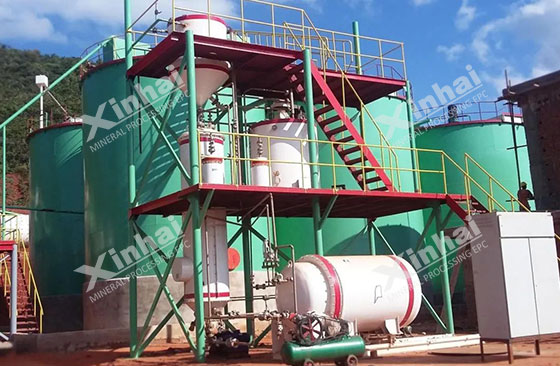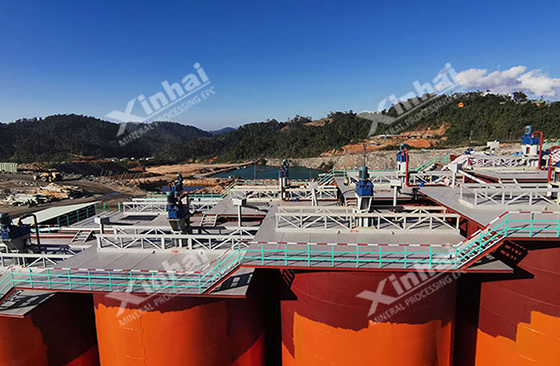
As the resources of easily processed gold ore are decreasing, refractory gold ore has gradually become the main ore source for gold production. The so-called refractory gold ore refers to gold ore with low total recovery rate of dressing and smelting, poor economic benefits, and process technology subject to environmental restrictions. This type of gold ore usually has a complex material composition and contains metal components that are difficult to extract. Therefore, it is necessary to conduct a detailed process mineralogy study on this type of gold ore. Through the study, we can understand the occurrence state, particle size distribution and embedding characteristics of gold, so as to find out the root cause of the difficulty in processing gold ore. This article will summarize five process mineralogy factors that affect the dressing and smelting of refractory gold ore.
The material composition of refractory gold ore has a crucial impact on its beneficiation process. Through chemical analysis, the content of gold, silver and other associated elements in gold ore can be determined, and the elements that can be comprehensively recovered can be identified. This process not only helps to select appropriate beneficiation methods, but also improves economic benefits.

Different types of gold minerals have different cyanide leaching effects, so it is particularly important to understand the types and relative contents of gold minerals. For example, some gold minerals have high solubility during cyanide leaching, while others are more resistant to dissolution. Through tools such as optical microscopes and electron probes, the types, contents and occurrence states of gold minerals can be identified, thereby providing a reference for the design of subsequent process flows.
The particle size of refractory gold ore is one of the key factors affecting their beneficiation and leaching effects. According to the different particle sizes, gold minerals can be divided into very fine, fine, medium, coarse and very coarse types. Generally, gold minerals with finer particle sizes require more delicate grinding treatment during the beneficiation process to achieve full dissociation and exposure of the minerals.
For refractory gold ores, the particle size of gold minerals is usually less than 10μm, and may even be ultra-microscopic gold or invisible gold. This type of gold mineral is difficult to recover directly through traditional gravity separation or flotation processes, and often requires microscopic analysis by high-precision instruments such as electron probes to determine its distribution characteristics. In addition, the shape of gold minerals also has an important influence on the beneficiation process. Granular gold minerals are easy to dissociate into monomers and are suitable for recovery by gravity separation processes, while gold minerals with irregular shapes or large surface areas may be more easily recovered during flotation.
.jpg)
The properties of gangue minerals are one of the important factors affecting gold ore dressing, especially in complex ores. When studying gangue minerals, special attention should be paid to the following aspects:
- The hardness of gangue minerals and their intercalation relationship with metal sulfides: If the hardness of gangue minerals is large, it may increase the difficulty of crushing and grinding, thereby affecting the recovery of gold.
- The content and properties of harmful minerals: Talc, serpentine, clay minerals, graphite and other harmful minerals will affect the grinding and leaching process. For example, graphite and carbonaceous substances will adsorb cyanide, thereby affecting the leaching efficiency of gold.
- The influence of carbonate minerals: If the ore contains a large amount of carbonate minerals, the acid consumption in the cyanide leaching process will increase, thereby reducing the leaching efficiency.
In addition, carbonaceous gold ores are also difficult to handle. The carbonaceous substances in such ores will not only affect the leaching of gold, but also cause gold loss. By analyzing the content and intercalation characteristics of gangue minerals, its influence on the mineral processing process indicators can be predicted.

In most refractory gold mines, gold often coexists with metal sulfides. Therefore, it is very important to find out the types of gold-bearing minerals and their symbiotic relationship with other associated minerals. The types of gold-bearing minerals, the characteristics of their dissemination, and the occurrence state of gold (such as inclusion gold, fissure gold, crystal gold, etc.) directly affect the selection and effect of the mineral processing technology. Especially for polymetallic sulfide gold mines, pyrite, arsenopyrite and other sulfide minerals are the main gold-bearing minerals. The comprehensive recovery of these minerals can improve the recovery rate of gold and realize the comprehensive utilization of ore.
Through reasonable mineral processing technology, associated minerals such as copper, lead, and zinc can be recovered at the same time to improve economic benefits. For example, obtaining gold-bearing copper concentrate, lead concentrate, and pyrite concentrate can not only improve the recovery rate of gold, but also maximize the utilization of mine resources.

The surface properties of gold minerals have two effects in the beneficiation process: one is supergene alteration, and the other is the influence of the beneficiation process. Supergene alteration usually manifests itself as the formation of oxides on the surface of gold minerals, such as iron oxide, silver chloride, etc., which will hinder the leaching of gold. During the mining and beneficiation process, a hydrated ion film will form on the surface of the mineral, affecting the adsorption and leaching of gold.
In addition, the phenomenon of adsorbed gold is more common in carbonaceous gold ores. This adsorbed gold is difficult to detect under an optical microscope or an electron microscope, but it often leads to gold loss during the beneficiation process. The formation of adsorbed gold may be the migration and re-adsorption process of gold during geological changes, or it may be formed during mineral processing. Therefore, reasonable pretreatment and process flow design are crucial to improving the recovery rate of gold.

For refractory gold ore, detailed process mineralogy research is the key to improving the recovery rate of gold ore dressing. By analyzing the material composition, particle size and shape of gold ore, the properties of gangue minerals, the symbiotic relationship with metal sulfides and the surface properties of gold ore, the key factors affecting the dressing process can be found. With the advancement of technology, scientific and reasonable dressing process design will help overcome these difficulties, further improve the comprehensive utilization rate of gold resources, and maximize economic benefits.
To find out more about our products and solutions, please fill out the form below and one of our experts will get back to you shortly.